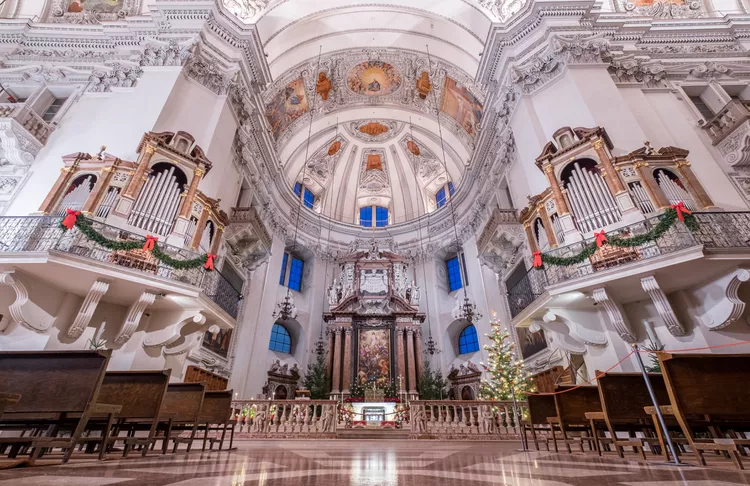Salzburg Cathedral: A Marvel of Baroque Art
Salzburg’s basilica is a landmark in the city— regardless of your beliefs, it is impossible to visit without exploring this great architectural gem. Gracefully crowned by a bulbous copper dome and twin spires, the Salzburg Cathedral (“Dom zu Salzburg” in German) stands out as a masterpiece of early baroque art. Situated in the heart of the historic center, it has been rebuilt three times over the centuries after suffering no less than ten fires. This grand structure still bears witness to the power of Salzburg’s archbishops today.
Every year, more than two million visitors explore the city’s religious center, where the illustrious composer Wolfgang Amadeus Mozart was baptized and performed some of his most beloved pieces. As a part of Salzburg’s historic center, it was recognized as a UNESCO World Heritage Site in 1997.
History
The origins of the cathedral date back to 774, built by Saint Virgil, an Irish priest known for his progressive views, including the belief in a round earth, which led to complaints addressed to the Pope. Less than 70 years following its construction, the cathedral fell victim to its first fire caused by a lightning strike.
In 1598, after the basilica had undergone expansions that included two towers and a crypt, another devastating blaze nearly destroyed it completely. Prince-Archbishop Wolf Dietrich von Raitenau, an enthusiast for modern Italian Baroque architecture, attempted to restore it, however, he ultimately ordered its demolition—much to the dismay of Salzburg’s residents. He commissioned Italian artist Vincenzo Scamozzi to design an entirely new cathedral, but his plans never materialized as the Prince-Archbishop was soon overthrown and died in prison. The subsequent Prince-Archbishop Markus Sittikus von Hohenems redirected Italian architect Santino Solari to modify Scamozzi’s plans, leading to the new basilica being consecrated in 1628, with the towers completing around 40 years later.
During World War II, tragedy struck once more; the Salzburg Cathedral was destroyed again when a bomb pierced the central dome. The structure we admire today was completed in 1959.
Highlights of the Visit
Before entering the cathedral, take a moment to appreciate the façade. The gates illustrate the three virtues: Faith, Love, and Hope, while the dates above them (774, 1628, 1959) remind us of the three times the cathedral was consecrated. Additionally, you will notice four impressive statues at the main entrance, representing Apostles Peter and Paul (identifiable by their keys and sword) along with the patron saints Virgil (whose vision brought about the original cathedral) and Rupert, the patron saint of Salzburg.
Once inside, your attention may be drawn to the baptismal font. Dating back to the early 1300s, this is the very spot where Wolfgang Amadeus Mozart was baptized on January 28, 1756, the day following his birth. He also frequently played the “Hoforgel,” one of five organs present in the cathedral. Today, the instrument is located on the southeast side of the church. Notably, legendary composer Joseph Mohr, known for “Silent Night,” was also baptized in this same font.
Next, gaze upward to admire the dome. At 232 feet (71 meters) high, it stands as the most striking feature of the Salzburg Cathedral, decorated with 16 frescoes depicting various scenes from the Old Testament. These works, painted by the Italian artisans Donato Mascagni and Ignazio Solari, are seamlessly connected to those on the cathedral’s nave.
Your visit wouldn’t be complete without exploring the crypt located on the right side of the main altar. Here, remnants of the first two churches can be found, alongside the tombs of many of Salzburg’s archbishops—excluding Wolf Dietrich von Raitenau, who rests in the cemetery at St. Sebastian’s Church & Cemetery on Linzer Gasse.
If you’re fortunate enough to visit during a church holiday, prepare for a delightful auditory experience: at precisely 3 p.m., all seven bells chime in harmony for several minutes. Each bell possesses a unique name, from Barbara (the smallest) to Salvator (the largest). Salvator weighs an astonishing 31,429 pounds (14,256 kilograms), holding the title of the heaviest bell in Austria, surpassed only by the “Pummerin” at St. Stephan’s in Vienna.
How to Visit
Locating the Salzburg Cathedral is straightforward, as it lies right in the heart of the old town. Positioned adjacent to Residence Castle and the Monastery of St. Peter, it sits on Domplatz, where “Jedermann” (Hugo von Hofmannsthal’s renowned play) is staged annually during the Salzburg Festival (“Salzburger Festspiele”).
The opening hours of the cathedral vary monthly. From January, February, and November, the cathedral operates from 8 a.m. to 5 p.m. Monday to Saturday, and 1 p.m. to 5 p.m. on Sunday. Meanwhile, in March, April, October, and December, it is open from 8 a.m. to 6 p.m. Monday to Saturday and 1 p.m. to 6 p.m. on Sundays. In May and August, you can visit from 8 a.m. to 7 p.m. Monday to Saturday and 1 p.m. to 7 p.m.
Although entrance to the cathedral and crypt remains free, there are intentions to implement an admission fee starting in July 2019. When planning your visit, keep in mind that the crypt is closed during mass services.
What to Do Nearby
The Salzburg Cathedral is part of the renowned DomQuartier. Since you’re already in the area, why not delve deeper into its offerings? An all-inclusive ticket costs between 10–12 euros, granting access to the Cathedral Museum, which showcases art treasures accumulated over 1300 years, including the Cross of St. Rupert from the eighth century. You can also explore the private staterooms of the Prince-Archbishops at the Residence Palace, as well as the Museum of St. Peter’s Abbey, where you can study historical artifacts and learn about the oldest monastery in the German-speaking world.
After enjoying the cathedral and exhibitions, take time to wander around the historic center, indulge in window shopping along Getreidegasse, and treat yourself to some famous “Mozart balls.”




